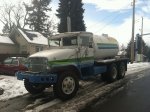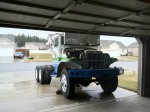Oldfarts 220 runs 55 all day long with the empty M-105 behind it, on the flat. It sniffs a hill and it slows down. The truck runs really good. I have been impressed. Everyone we talked to said they are slow as molasses in January. But honestly it out performs all of the stock M-37's I've run. And the brakes will shut her down.
I just drive it like all my other MV's. Tons of room left to stop. I'm not in a hurry to accelerate. Put myself in a clear traffic area, i.e. no cars around me. Anticipate traffic and let people merge in front so they don't get upset about being stuck behind the big truck. Common sense stuff the Oldfart taught me.

I would check for the simple things first. Is it stuck in low? Great question. Vaccum line check. Etc.
But with your explanation of not starting after it's cold or sitting for a period of time and you have to wet the cylinders to get it to start I would suspect low compression. I have had a lot of old GM inline 6's that have worn out and needed rebuilt or replaced. Most due to loss of compression.
Low compression. Hole in the top of the piston (detonation). Not likely. Valve(s) worn or damaged. Possible but usually accompanied by a dead hole or missfire. ALL of the valves don't usually go bad at the same time. Stuck or worn rings/worn cylinders. Most likely.
Bad rings/worn cylinders. Symptoms. Hard starting cold to impossible to start cold. Improvement in starting wetting cylinders. Excessive blow by into the crankcase. Low compression check numbers. Spark Plug fouling. Buring oil in the exhaust. Oil consumption. Raw oil in the exhaust.
Honestly a leakdown test is more accurate than a compression test but for these purposes a compression test will narrow down the problem Cylinders and or if the engine is just plain worn out. And a compression test is easier to perform and the test tools are cheap to get.
Good luck and keep us in the loop.
![Thumbs Up [thumbzup] [thumbzup]](https://www.steelsoldiers.com/images/smilies/icon_smile_thumzup.gif)



